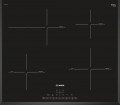Bridge mode
A function that allows you to combine two (or more) adjacent electric hotplates into one burner. Often, this mode is found in induction hobs, less often in Hi-Light, and is not used in gas hobs. Often the "bridge" looks like one continuous heater of an elongated shape, the individual parts of which can be turned on independently and are separate burners. Anyway,
the bridge mode (Bridge) can be useful primarily for working with elongated utensils — for example,
goose roasters. In addition, the design may provide various additional functions — for example, the ability to set different power settings for different parts of the "bridge" and move the dishes between them depending on the readiness of the dish. At the same time, unlike conventional burners, the heating will turn on automatically, according to the presence of dishes on the burner.
Oval dual zone
The presence of an
oval-shaped heating zone on the hob. Such a heater is useful for working with appropriate elongated dishes (for example, goose roasters). In models with electric heaters (see "Burner type") the desired shape is provided by an additional segment installed close to the burner; the burner in normal mode works like a regular round one, and when the segment is connected, it turns into an oval. In gas models, a separate elongated burner is installed.
A similar effect can be achieved using the bridge mode (see "Features"). However, the bridge and the oval zone are still different functions: the first involves combining two burners, and the second is implemented strictly on one burner.
Burners power
Nominal burners power. It refers to the power consumption of the heater. This parameter allows you to estimate how much electricity the burners will spend when operating at maximum heating intensity. At the same time, the heat transfer power of different burners can be different, and the actual heating efficiency will also greatly depend on the specs of the dishes. As a result, it hardly makes sense to evaluate the working capabilities of the hob by the power of the burners. It is quite possible to proceed from the fact that the burner will be enough for a pot of the same diameter.
Burner diameter
The heating power directly depends on the diameter of the burners. And, at the same time, the performance of the device and the speed of cooking. The larger the burner, the more heat dissipation it has. Also, the diameter of the burner allows you to determine what sizes of dishes are suitable for use on the hob. Indeed, for induction models, this value is critical for high-quality heating. Burners can have the following diameter:
- small — about 145 mm, power within 1200 W;
- medium — about 180 mm, power within 1700 W;
- large — about 220 mm and more, power within 2000 watts.
Some hobs use double ring burners that allow you to adjust the diameter of the heating zone. If the diameter of the burner is 180, 200, 220 mm, then it means that the heating zone on a particular burner can be narrowed or expanded, depending on the size of the dishes used.
Automatic programmes
—
Boil detection. A system based on a sensor that monitors the state of the product being cooked (usually by the temperature of the dishes): before the water boils, the burner operates at maximum, and after boiling, the sensor reduces the intensity of work to a certain value. The point of this adjustment is that much less heat is needed to maintain the boil than to heat it up to the boiling point; moreover, if you do not reduce the heat, the liquid can spill. Accordingly, automatic boiling allows not only to save energy but also to avoid such troubles. This function is found in electric models (see Product type).
—
Keep warm function. The keep warm function keeps food warm until served. It will come in handy in cases where dinner is already cooked and the guests have not yet arrived. The maximum time for keeping heat usually does not exceed 1-2 hours.
—
Melting. Special mode for low-temperature thawing of small portions of frozen food, melting butter or chocolate. The function allows you to carefully melt the necessary ingredients into a mass of a homogeneous structure without fear that they will burn or overheat.
—
Auto fry function. The pre-set automatic frying mode, which ensures that the temperature of the bottom of the dishes is maintained at the optimum temperature, preventing it from cooling down or over
...heating. An auto fry programme usually provides several cooking modes for different tasks.
— Additional. Several specific auto-programmes used in individual hobs and not covered by the list above.
Input power
The input power of the hob is the maximum electric power consumed during its operation. This parameter is indicated only for models that are equipped with at least one electric hotplate. It is electric burners that are the highest consumption in terms of energy consumption. Additional functions such as auto-ignition require little energy, and a regular outlet is enough for them.
First of all, the requirements for the power mains depend on this parameter: it must be able to provide such power without overloads. It is worth noting that for household sockets the power limit is about 3 – 3.5 kW, with more power, you need to connect the hob to 230 V mains according to special rules. An alternative is to use a three-phase 400 V mains: most modern hobs with electric burners allow connection to both 230 V and 400 V mains.
Dimensions (WxD)
General dimensions of the device in width and depth. Depth, in this case, refers to the distance from the leading edge to the trailing edge (when viewed from the user's side). Note that the external dimensions of the hobs are often larger than the dimensions for embedding (see below).

